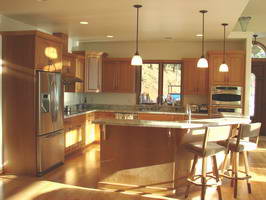How to Prevent Generator Overload and a Tripped Circuit
 '; ';
|
How can I set up a small generator to keep my essential items powered up? How to Identify Home Circuits and Prioritize the Run Time. © By: Dave Rongey |
A Cure for Home Generator Overload
Electrical Project: How can I set up a small generator to keep my essential items powered up?
- My home generator is not very large and I am trying to provide power for several of my home electrical circuits.
- What can I do to make this work and keep essential items powered up?
- The recent storm has really caused problems and we be without power for several days.
Do you have any ideas?
Thanks for Your Help,
Robert.
This home electrical question came from: Robert, a Homeowner from Staten Island, New York.
Additional Comments: Thanks for this website and your help, it is very helpful!
Dave’s Reply:
Thanks for your home electrical question Robert.
Small Generator for Emergency Power
- Application: Generator Cord and Receptacle Outlet.
- Skill Level: Advanced – Not recommended for Homeowners. This electrical wiring project is best performed by a Licensed Electrical Contractor or Certified Electrician.
- Tools Required: Electricians pouch of hand tools.
- Estimated Time: Depends on the type and size of the generator output, the specific receptacle, and the available access to the project area.
- Note: Generator power should always be wired through an approved transfer switch or circuit interlock device. Any part of the home electrical system must NEVER be back-fed using a cheater cord. Back-feeding is extremely hazardous for the home, the occupants and the electric utility company repairmen.
- Important: Installing a generator and transfer switch must be well thought out and performed with a permit with all work being inspected.
How to Make a Smaller Generator Work When You Need Power
Identify Home Electrical Circuits and Prioritize the Run Time
A smaller generator may still be helpful if you follow this method for your home electrical requirements.
- FIRST THINGS FIRST:
Make sure your generator is connected to the home using a transfer switch or an interlock kit or similar device which will ensure the following:- Prevent feeding generator power into the grid or the electric utility company service wires. If your generator is feeding power into the neighborhood this can electrocute high voltage linemen that are trying to repair the electrical system, plus you will be trying to provide power for all your neighbors and this will overload your generator.
- Prevent damage to your generator when the power is restored from the electric utility company. If your generator is connected when the utility power is restored then the generator may suffer extensive and permanent damage.
The Process to Reduce the Load on a Smaller Generator
- Identify all the essential circuits such as lighting, counter top receptacle outlets.
- These circuits may stay on as long as there is not a lot of use, such as a lot of lights that are on, or a microwave oven that is being used.
- Identify all the essential dedicated circuits for larger equipment that is essential, such as:
- Septic Pump
- Well Pump
- Refrigerator
- Label the circuit breakers so you may schedule when the circuits will operate.
- Identify and turn OFF any non-essential circuits for devices or equipment that you can do without during the power outage.
- Create a schedule or time when the essential dedicated circuits can be turned on and only operate one at a time. This will prevent the generator from overloading and keep the voltage from dropping.
The goal is to prevent the generator from overloading or the voltage from dropping which can lead to a damaged device, especially power sensitive electronic devices including Computers and Televisions, basically anything with electronic circuitry.
Large devices or equipment such as an electrical water heater, all electric clothes dryer, range, cook top, or oven – these devices require a great deal of electricity and if the generator is not substantially large then it would be best to turn these circuits off and not use the devices.
- IMPORTANT
Some circuits that provide power to equipment that has a motor may require more power than a small generator can produce, this would include equipment such as a Well Pump, Clothes Dryer, Furnace or Heat Pump.
How to Prevent Generator Overload and a Tripped Circuit
More about Home Generators
Generators for the Home
This series covers a wide variety of topics all about home generators including sizing, selecting, connecting and safely operating this all important addition to your home.
Basic Residential House Wiring Circuits
House Wiring Circuits and Circuit Breakers
This article looks at common 120 volt and 240 volt house wiring circuits and the circuit breakers that are installed identifying the types and amperage sizes used in most homes.
Electrical Panel Circuit Listing
The following may also be helpful for you:
|
|
Be Careful and Be Safe - Never Work on Energized Circuits!
Consult your Local Building Department about Permits and Inspections for all Electric Wiring Projects.
More articles about Connecting a Generator, Generator, Home Generator, Wiring Generators and Home Electrical Wiring: |
|
| « Previous | Next » |
Replacing a 3Way Switch with a Time Switch |
Installing Electrical Radiant Heat Floor Mats |















